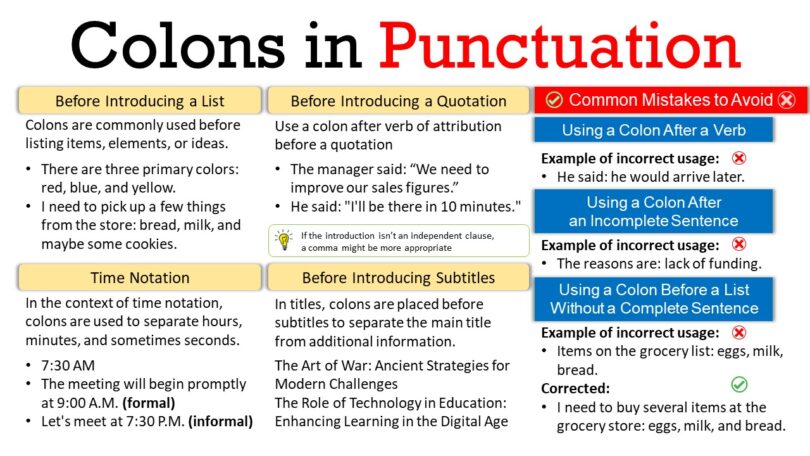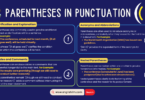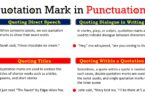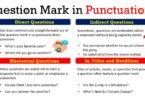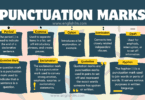In written language, punctuation marks are essential for expressing meaning and clarity. Among them, the colon is a particularly useful and effective symbol. The colon, in spite of its relatively straightforward appearance, has a number of purposes that can greatly improve the consistency and organization of your work. We’ll go into the subtleties of employing colons successfully in this blog post, covering their various applications and offering helpful advice for confidently utilizing them in your writing.
Introduction to the Colon
The colon (:) is a punctuation mark with several important uses in written language. It is often misunderstood or misused, but when used correctly, it can enhance clarity and organization in your writing.
What is a Colon?
A colon (:) is a punctuation mark used primarily to introduce or emphasize the material that follows it.
Its primary purposes include:
- Introducing Lists
- Introducing Explanations or Examples
- Introducing Quotations
- Introducing Subtitles
- Time Notation
Read more about: Punctuation Marks
Uses of Colon
In English, colons are placed at the end of a clause or phrase, typically before introducing a list, explanation, example, or quotation. Here are some guidelines for colon placement and use:
1 – Before Introducing a List
Colons are commonly used before listing items, elements, or ideas. The colon signals to the reader that a list is about to follow.
For example:
- There are three primary colors: red, blue, and yellow.
- The conference will cover three main topics: sustainability, innovation, and global trends. (formal)
- I need to pick up a few things from the store: bread, milk, and maybe some cookies. (informal)
2 – Before Introducing an Explanation or Example
Colons can precede explanations, clarifications, or examples that elaborate on the preceding statement.
For example:
- The reason is simple: he didn’t study for the exam.
- She had one hobby she enjoyed most: painting.
- The company’s success can be attributed to one factor: a commitment to excellence in customer service. (formal)
- The party was a blast: lots of music, dancing, and laughter. (informal)
3 – Before Introducing a Quotation
Colons are often used before a direct quotation, especially in formal writing, to indicate that what follows is a quote or excerpt.
For example:
- The manager said: We need to improve our sales figures.
- The CEO emphasized the importance of teamwork: “Together, we can achieve our goals and drive success.” (formal)
- He said: “I’ll be there in 10 minutes.” (informal)
4 – Before Introducing Subtitles:
In titles, colons are placed before subtitles to separate the main title from additional information.
For example:
-
- The Art of War: Ancient Strategies for Modern Challenges
- The Role of Technology in Education: Enhancing Learning in the Digital Age (formal)
- Cooking Adventures: Recipes from My Kitchen (informal)
5 – Time Notation:
In the context of time notation, colons are used to separate hours, minutes, and sometimes seconds.
For example:
-
- 7:30 AM (seven thirty in the morning)
- The meeting will begin promptly at 9:00 A.M. (formal)
- Let’s meet at 7:30 P.M. (informal)
It’s essential to remember that colons should be utilized carefully to improve the writing’s clarity and order rather than being inserted at random. Furthermore, depending on the style guide being followed, colons may or may not be followed by a single space after they are placed. Normally, they are not.
Read more about: Period or Full Stop
- What is a colon in punctuation?
- A colon (:) is a punctuation mark used to introduce related or explanatory information, list items, quotations, or subtitles in written text.
- How is a colon different from a semicolon?
- While both are punctuation marks, a colon is primarily used to introduce or emphasize information, whereas a semicolon is used to connect closely related independent clauses or separate items in a list when the items themselves contain commas.
- When should I use a colon in my writing?
- You should use a colon to introduce lists, explanations, examples, quotations, or subtitles. It typically follows a complete sentence or independent clause and signals that what follows is directly related to or elaborates on the preceding clause.
- Can I use a colon after any word or phrase?
- No, a colon should not directly follow a verb unless it’s part of a formal structure like a quotation. It’s typically used after a complete sentence or independent clause.
- How should I format time notation with a colon?
- Time notation should be formatted with a colon to separate hours, minutes, and sometimes seconds. For example, 9:00 A.M.
- Are there any common mistakes to avoid when using a colon?
- Yes, common mistakes include incorrectly placing a colon after a verb, using a colon after an incomplete sentence, or overusing colons. It’s essential to use them judiciously and ensure they follow a complete sentence or independent clause.
- Can I use a colon in a headline or title?
- Yes, colons can be used in headlines or titles to separate main titles from subtitles or additional information. They help provide clarity and structure to the title.
- How can I use a colon to enhance emphasis in my writing?
- You can use a colon to create emphasis by introducing dramatic pauses, highlighting important points, or creating anticipation for what follows. However, it’s important to use them appropriately and sparingly for maximum impact.
- Is there a difference in using colons in formal versus informal writing?
- While the basic rules for using colons remain the same, their usage may vary slightly depending on the formality of the writing. In formal writing, colons are used more conservatively, whereas in informal writing, such as emails or social media posts, they may be used more creatively.
- How can I improve my usage of colons in writing?
- Practice using colons in various contexts, pay attention to their usage in published writing, and seek feedback from peers or instructors. Familiarizing yourself with the rules and conventions of colon usage will help you use them effectively in your own writing.


